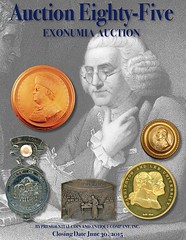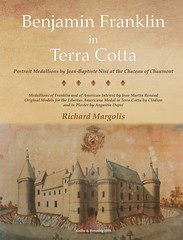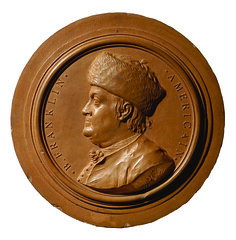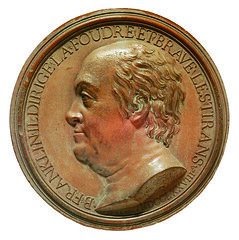
PREV ARTICLE
NEXT ARTICLE
FULL ISSUE
PREV FULL ISSUE
BOOK REVIEW: BENJAMIN FRANKLIN IN TERRA COTTA
David Alexander submitted a review of Richard Margolis’ new book, Benjamin Franklin in Terra Cotta. Thanks! -Editor
Review by David Thomason Alexander, Fellow ANS, Founder Medal Collectors of America. Among the most fascinating contemporary collectibles relating to statesman-philosopher Benjamin Franklin are the terra cotta portrait medallions created at Chaumont-sur-Loire, France by the great Italian ceramic artist Jean-Baptiste Nini, born Urbino, Papal States, 1717-1786. Nini worked from from Royal Master of Rivers and forests Jacques Donatien Leray’s Chateau de Chaumont with its pottery and glass works. Leray was Franklin’s friend and provided his lodgings and offices in the picturesque village of Passy outside bustling Paris. Nini created a myriad of portrait medallions from durable terra cotta (terre cuit) portraying French Kings, noblemen and women, influential clergymen, savants and philosophes, and such foreign notables as Empress Catherine the Great of Russia. To American collectors and savants, his greatest achievement is the group of portrait medallions of B. Franklin Americain in 1777-1779, Ben Franklin as American envoy to France. Books and catalogs including them have appeared since Franklin’s own day, but 2015 has seen the release of what may well be the last word of Nini-Franklin study: Richard Margolis’ Benjamin Franklin in Terra Cotta, Portrait Medallions by Jean-Baptiste Nini at the Chateau of Chaumont. (Kolbe and Fanning, 141 West Johnstown Road, Gahanna, Ohio 43230, 2015. 13¼ x 10 inches. Hard cover, 232 pages, profusely illustrated in color. This book can be ordered from the publisher, at $195.00 per copy. This massive hardcover work must be described as a signal achievement in book design as well as an exhaustive work in a long-neglected area of U.S. and French numismatics. It is the culmination of decades of research and collecting by author Margolis, long a leading figure in the fields of French and early American numismatics and the history of the medal. Now based in New Jersey, he has been a pioneer in world numismatics in the U.S. since the 1950’s. He was the founder of the New York International Numismatic Conventions (NYINC) in 1972 and of the Societé pour l’Etude de la Numismatique Française and was originally one of the key players in the International Numismatic Society (INS) in the 1980’s. In the interest of full disclosure, this reviewer wishes to note that he attended NYINC conventions virtually since the beginning, initially as a Coin World writer. He and his bride Pat enjoyed their honeymoon at the December 1977 NYINC, a claim that few can rival! Along with many other American collectors, the reviewer encountered the terra cotta portrait medallions of B. Franklin Americain early in his collecting career. In his later years as lead cataloguer for such firms as Kagin’s and Stack’s-Coin Galleries, he cataloged several examples, doing as much in-depth research into these classic Franklin portraits as old-established coin firm libraries would permit. The only generally available reference in the 1980’s was “Medallic Memorials to Franklin” by George and Melvin Fuld, published in The Numismatist, journal of the American Numismatic Association (ANA). Frequently cited in European catalogs was A. Storelli’s Jean-Baptiste Nini. Sa vie – son oeuvre, 1717-1786. (Tours, Imprimerie A. Mame et fils, 1896). This was long regarded as the standard work, listing 107 medallions, among them nine different Franklins. However, it was generally unavailable to American auction catalogers at that time. Nini was featured in an eight-page listing in Leonard Forrer’s great Biographical Dictionary of Medallists (London, Spink & Son, 1909). Forrer was very thorough with the material at hand but introduced some long-lived inaccuracies, notably his assertions that the Franklin medallions were made with steel moulds and hand- finished after casting by the master himself. Among later works was Phil W. Greenslet’s The Medals of Franklin. A Catalog of the Medals, Tokens, Medallions and Plaques issued in Honor of Franklin (Token and Medal Society, Lake Mary, Florida, 1993). Greenslet, like the Fulds, presented little more than a list with minimal detail of the kind sought by a competent cataloger. More recently, Richard Margolis introduced the reviewer and other Americans to the remarkable work of Anna Cerboni Baiardi and Barbara Sibille,1717-1786, Jean-Baptiste Nini, d’Urbino aux rives de la Loire. Paysages et Visages européens, (Federico Motta editore, Milano 2001). Here was a lavishly illustrated 304-page record of an epic Franco-Italian exhibition featuring a cross section of all Nini’s terra cotta portraits “on the banks of the Loire.” In his detailed examination of Nini’s Franklin terra cottas, Margolis identifies 18 “Petite Module Medallions and Moulds” (measuring up to 127 millimeters) and eight “Grand Module Medallions and Moulds (156 to 165mm) by or after Jean-Baptiste Nini.”
Franklin enchanted the Parisians by his distinctive, democratic style of dress, notably his “old brown coat” and the fur hat that were swept up in the fad for “Franklin fashions” by the novelty-loving populace of the French capital. Franklin described himself and his hat in a letter of Jan. 12, 1777 to Mary Hewson as “an old Man with grey Hair appearing under a Martin Fur Cap, among the powdered Heads of Paris.” He had brought this headgear back from his journey to Canada in May 1776, and wore it often during his first winter in Paris in place of the conventional wig. The French public identified it with him, and it instantly acquired iconic status. As writer Claude-Anne Lopez wrote, the circular head piece was “un bonnet de fourrurte, et sentant que cette coiffure liait, dans l’imagination des Français, philosophie et liberté, il reproduisit le bonnet de fourrure de Rousseau.” Identification with revolutionary thinker Jean-Jacques Rousseau reinforced the democratic value of informality in dress. Margolis then lists three fur hat types with “lunule” spectacles of Franklin’s own invention with no legend, followed by nine types with fur hat and legend B. FRANKLIN AMERICAIN. The latter are the Nini medallions most familiar to American collectors, as they were produced in quantity and readied for shipment to America. Margolis notes several varieties based on lettering, stops, Arms on truncation, dates and impressed fleur de lis on reverse. Margolis Type 18 (Forrer IV:268-276, Fuld FR.ME.NL-2 Nini). is the variety most likely to be encountered by American collectors today. Examination of the example in the reviewer’s collection with Margolis text in hand reveals that the medallion is uniface Terracotta, 117 to 116.4mm in diameter. The outer rim thickness is 6.8mm at 12:00; 7mm at 6:00. The obverse presents a high-relief clothed bust l. with long hair escaping from the fur hat. The serif-style French legend is separated by quatrefoil stops, * B. FRANKLIN * - *AMERICAIN *. The letters IN are weak. The truncation bears incuse NINI/ F 1777, with 1777 repeated in field below. Also on the truncation is the fictional Arms, an oval shield displaying an arm flying a kite that attracts lightning, topped by a "fantasy coronet" with palms at sides. A key feature in variety identification is the tiny relief rosette appearing on the second step of the integral frame at 12:00. The reverse bears a small incuse fleur de lis inset near 10:00. This specimen shows an ancient chip crudely repaired near the tubular hanger extending through the rim and out the back. The back of this example is not flat, and the piece wobbles when set on a flat surface. The patina is a rich saddle-brown. Many of the medallions surviving today came from a shipment of five or six cases, each containing a hundred medallions, lost in shipwreck near coast of Noirmoutier on their way to United States. Salvaged cases lay forgotten in a Nantes warehouse until 1830, when Customs sold them for a song to the French Navy. A collector, M. Myrvoix, obtained four boxes of medallions, sold two boxes to an official in Angoulême. Others were offered by Spink and Son in England in 1899. All had been carefully packed in a form of stiff paper and were found to be as fresh as the day they were cast.
Appendices following the catalog listing include data on important collections holding Nini medallions and an exhaustive examination and partial reconstruction of the methods used by Nini to produce his terra cotta work. Margolis’ careful attention to earlier studies includes a list of corrections to Charles Coleman Sellers’ widely read 1962 Benjamin Franklin in Portraiture. A particularly valuable aspect of Margolis’ book is his in-depth study of aftercasts or surmoulages, beginning May 1786, when young potter Jacques Mercier leased the pottery works from Leray upon Nini’s death with the specific right to use coins orginaux, original dies. On Aug. 8, 1788, local notary Orien Marais argued against Nini’s heirs receiving payment from later medallion sales, citing excessive profits from sale of aftercasts as originals. Alfred Viliers was author of Jean-Baptiste Nini, ses terres cuites. (Blois, Imprimerie Lecesne, 1862). Marquis Albert des Méloizes of Bourges wrote about Nini and had terra cotta molds made to show the process, these escaping his control only to reappear as originals in later years! By far the leading creator and marketer of deceptive Nini copies was Blésois ceramicist Émile Balon, active in the early 1890’s into 1920’s when he was succeeded by Gaston Bruneau. The reviewer encountered one of Balon’s fur hat-spectacles aftercasts while the John J. Ford Hodder collection was being cataloged at Stack’s in 2005. He needed another specimen for comparison with a recently consigned supposed original from another consignor, unaware that one was actually concealed in-house by the primary Ford cataloger who was typically reluctant to share. In the event, both pieces proved to be Balon copies. Margolis also offers discussion of rare Franklin terra cotta medallions by Jean Martin Renaud and a lengthy study of terra cotta models for the great Libertas Americana Medal which he attributes to sculptor Claude Michel, known as Clodion. An entire book could easily be written about this medal and the roles played by Clodion and Dupré in its creation. The reader is referred to the 13 pages devoted to it by the ever-thorough Margolis. No serious collector of Americana and no self-respecting library can be without Richard Margolis’ Benjamin Franklin in Terra Cotta. Both author and publisher have earned the gratitude of the entire numismatic community. Once again, orders should be addressed to Kolbe and Fanning, 141 West Johnstown Road, Gahanna, Ohio 43230.
David's review was also published in CoinWeek. See the Kolbe & Fanning ad elsewhere in this issue, or click the link below to
purchase a copy. -Editor
To read the CoinWeek article, see:
For more information, or to purchase, see:
To read the earlier E-Sylum article, see:
TOKEN, MEDAL AND POLITICAL AUCTION
Presidential Coin & Antique Co., Inc.'s Auction Eighty-Five of Tokens, Medals and Political items closes June 30, 2015. Hardcopies $6 - contact Joe Levine at Jlevine968@aol.com or view the catalog online here . Hard Times Tokens, 19th Century Storecard Tokens, Civil War Tokens, Military & Related, So-Called Dollars, Presidential & Political, World's Fairs & Expositions, U.S. Mint Medals, ANS Medals, Foreign Tokens and Medals, and MORE! Wayne Homren, Editor The Numismatic Bibliomania Society is a non-profit organization promoting numismatic literature. See our web site at coinbooks.org. To submit items for publication in The E-Sylum, write to the Editor at this address: whomren@gmail.com To subscribe go to: https://my.binhost.com/lists/listinfo/esylum All Rights Reserved. NBS Home Page Contact the NBS webmaster 
|


